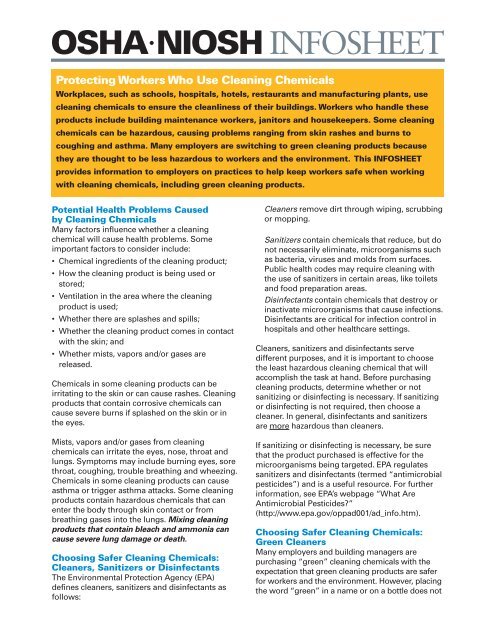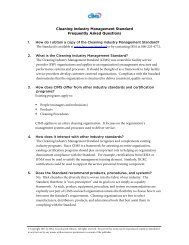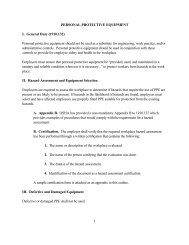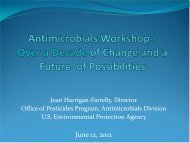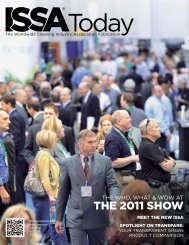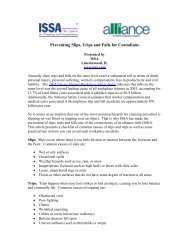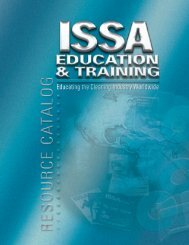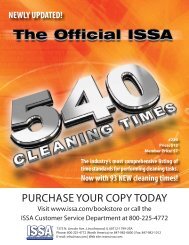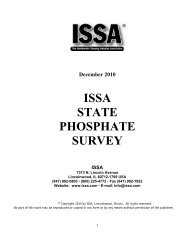Protecting Workers Who Use Cleaning Chemicals - OSHA
Protecting Workers Who Use Cleaning Chemicals - OSHA
Protecting Workers Who Use Cleaning Chemicals - OSHA
Create successful ePaper yourself
Turn your PDF publications into a flip-book with our unique Google optimized e-Paper software.
<strong>OSHA</strong> • NIOSH INFOSHEET<br />
<strong>Protecting</strong> <strong>Workers</strong> <strong>Who</strong> <strong>Use</strong> <strong>Cleaning</strong> <strong>Chemicals</strong><br />
Workplaces, such as schools, hospitals, hotels, restaurants and manufacturing plants, use<br />
cleaning chemicals to ensure the cleanliness of their buildings. <strong>Workers</strong> who handle these<br />
products include building maintenance workers, janitors and housekeepers. Some cleaning<br />
chemicals can be hazardous, causing problems ranging from skin rashes and burns to<br />
coughing and asthma. Many employers are switching to green cleaning products because<br />
they are thought to be less hazardous to workers and the environment. This INFOSHEET<br />
provides information to employers on practices to help keep workers safe when working<br />
with cleaning chemicals, including green cleaning products.<br />
Potential Health Problems Caused<br />
by <strong>Cleaning</strong> <strong>Chemicals</strong><br />
Many factors influence whether a cleaning<br />
chemical will cause health problems. Some<br />
important factors to consider include:<br />
• Chemical ingredients of the cleaning product;<br />
• How the cleaning product is being used or<br />
stored;<br />
• Ventilation in the area where the cleaning<br />
product is used;<br />
• Whether there are splashes and spills;<br />
• Whether the cleaning product comes in contact<br />
with the skin; and<br />
• Whether mists, vapors and/or gases are<br />
released.<br />
<strong>Chemicals</strong> in some cleaning products can be<br />
irritating to the skin or can cause rashes. <strong>Cleaning</strong><br />
products that contain corrosive chemicals can<br />
cause severe burns if splashed on the skin or in<br />
the eyes.<br />
Mists, vapors and/or gases from cleaning<br />
chemicals can irritate the eyes, nose, throat and<br />
lungs. Symptoms may include burning eyes, sore<br />
throat, coughing, trouble breathing and wheezing.<br />
<strong>Chemicals</strong> in some cleaning products can cause<br />
asthma or trigger asthma attacks. Some cleaning<br />
products contain hazardous chemicals that can<br />
enter the body through skin contact or from<br />
breathing gases into the lungs. Mixing cleaning<br />
products that contain bleach and ammonia can<br />
cause severe lung damage or death.<br />
Choosing Safer <strong>Cleaning</strong> <strong>Chemicals</strong>:<br />
Cleaners, Sanitizers or Disinfectants<br />
The Environmental Protection Agency (EPA)<br />
defines cleaners, sanitizers and disinfectants as<br />
follows:<br />
Cleaners remove dirt through wiping, scrubbing<br />
or mopping.<br />
Sanitizers contain chemicals that reduce, but do<br />
not necessarily eliminate, microorganisms such<br />
as bacteria, viruses and molds from surfaces.<br />
Public health codes may require cleaning with<br />
the use of sanitizers in certain areas, like toilets<br />
and food preparation areas.<br />
Disinfectants contain chemicals that destroy or<br />
inactivate microorganisms that cause infections.<br />
Disinfectants are critical for infection control in<br />
hospitals and other healthcare settings.<br />
Cleaners, sanitizers and disinfectants serve<br />
different purposes, and it is important to choose<br />
the least hazardous cleaning chemical that will<br />
accomplish the task at hand. Before purchasing<br />
cleaning products, determine whether or not<br />
sanitizing or disinfecting is necessary. If sanitizing<br />
or disinfecting is not required, then choose a<br />
cleaner. In general, disinfectants and sanitizers<br />
are more hazardous than cleaners.<br />
If sanitizing or disinfecting is necessary, be sure<br />
that the product purchased is effective for the<br />
microorganisms being targeted. EPA regulates<br />
sanitizers and disinfectants (termed “antimicrobial<br />
pesticides”) and is a useful resource. For further<br />
information, see EPA’s webpage “What Are<br />
Antimicrobial Pesticides”<br />
(http://www.epa.gov/oppad001/ad_info.htm).<br />
Choosing Safer <strong>Cleaning</strong> <strong>Chemicals</strong>:<br />
Green Cleaners<br />
Many employers and building managers are<br />
purchasing “green” cleaning chemicals with the<br />
expectation that green cleaning products are safer<br />
for workers and the environment. However, placing<br />
the word “green” in a name or on a bottle does not
ensure that a chemical is safe. Employers should review<br />
the cleaning chemicals they purchase,<br />
including green cleaning products, to understand<br />
their health and safety hazards. Employers should<br />
choose the least hazardous cleaners.<br />
Independent organizations are now certifying<br />
chemicals, including cleaners, as “green.” Certified<br />
green cleaners must meet specific criteria as<br />
defined by the certifying organization. Employers<br />
may find information from these certifying<br />
organizations helpful when purchasing cleaning<br />
chemicals. Some certifying organizations are<br />
listed under the Resources section below. The EPA<br />
webpages “<strong>Cleaning</strong>” (http://www.epa.gov/epp/<br />
pubs/products/cleaning.htm) and “Greening Your<br />
Purchase of <strong>Cleaning</strong> Products: A Guide for<br />
Federal Purchasers” (http://epa.gov/epp/pubs/<br />
cleaning.htm) provide comprehensive guidance for<br />
purchasers of cleaning products.<br />
Choosing Safer <strong>Cleaning</strong> <strong>Chemicals</strong>:<br />
Material Safety Data Sheets<br />
When choosing safer cleaning chemicals,<br />
employers can learn much from Material Safety<br />
Data Sheets (MSDSs). Employers must obtain and<br />
maintain MSDSs for all hazardous cleaning<br />
products and chemicals that they use. MSDSs<br />
must be readily accessible to workers. Employers<br />
can use the information contained in the MSDSs to<br />
ensure that workers are properly protected. MSDSs<br />
include the following important information:<br />
• Hazardous chemical ingredients;<br />
• Symptoms and health problems that may be<br />
caused by the chemical ingredients;<br />
• First-aid measures if workers are exposed;<br />
• Recommended personal protective equipment,<br />
such as gloves, safety goggles or respirators;<br />
and<br />
• Proper procedures for cleaning up spills.<br />
Safe Work Practices When Using<br />
<strong>Cleaning</strong> <strong>Chemicals</strong><br />
Employers must provide safe working conditions<br />
for employees using cleaning chemicals. When<br />
cleaning chemicals are hazardous, employers<br />
must train workers on safe work practices for<br />
using these chemicals. Safe work practices when<br />
using cleaning chemicals include the following:<br />
• Warning workers not to mix cleaning products<br />
that contain bleach and ammonia;<br />
• Making sure that workers know which cleaning<br />
chemicals must be diluted and how to correctly<br />
dilute the cleaners they are using;<br />
• Thoroughly reviewing and training workers on<br />
the use, storage and emergency spill procedures<br />
for cleaning chemicals;<br />
• Reviewing the proper protective equipment<br />
needed, such as gloves and goggles, and<br />
providing the proper protective equipment to<br />
the workers using the cleaning product;<br />
• Ensuring that all containers of cleaning<br />
products and chemicals are labeled to identify<br />
their contents and hazards;<br />
• Operating ventilation systems as needed during<br />
cleaning tasks to allow sufficient air flow and<br />
prevent buildup of hazardous vapors; and<br />
• Providing workers with a place to wash up after<br />
using cleaning chemicals.<br />
WorkerTraining<br />
<strong>Chemicals</strong> pose a wide range of health and safety<br />
hazards. <strong>OSHA</strong>’s Hazard Communication standard<br />
(29 CFR 1910.1200) is designed to ensure that<br />
information about these hazards and associated<br />
protective measures is communicated to workers.<br />
Worker training must be provided if the cleaning<br />
chemicals are hazardous. This training must be<br />
provided BEFORE the worker begins using the<br />
cleaner. Required training under the <strong>OSHA</strong> Hazard<br />
Communication standard includes:<br />
• Health and physical hazards of the cleaning<br />
chemicals;<br />
• Proper handling, use and storage of all cleaning<br />
chemicals being used, including dilution<br />
procedures when a cleaning product must be<br />
diluted before use;<br />
• Proper procedures to follow when a spill occurs;<br />
• Personal protective equipment required for using<br />
the cleaning product, such as gloves, safety<br />
goggles and respirators; and<br />
• How to obtain and use hazard information,<br />
including an explanation of labels and MSDSs.<br />
The following are important issues to be discussed<br />
with workers during training:<br />
• Never mix different cleaning chemicals together.<br />
Dangerous gases can be released.<br />
• <strong>Cleaning</strong> chemicals should not be used to wash<br />
hands. Wash hands with water after working<br />
with a cleaning chemical, especially before<br />
eating, drinking or smoking.<br />
Employers must provide training to workers at a<br />
level and in a language and vocabulary that they<br />
can understand.
Better Ways to Clean<br />
Employers should note recent advances in safe<br />
cleaning practices and the availability of modern<br />
cleaning equipment that minimizes the use of<br />
chemicals. Practices and equipment to consider<br />
include:<br />
• Walk-off mats placed inside and outside of entryways<br />
(to prevent dirt from being tracked into the<br />
building);<br />
• Microfiber mops, cloths and dusters;<br />
• High-filtration HEPA vacuums;<br />
• Walk-behind hard floor auto-scrubbers;<br />
• Hands-free mops; and<br />
• Chemical-free cleaning systems.<br />
Building owners and planners should take<br />
building cleaning into consideration when<br />
designing new buildings, remodeling old buildings<br />
and choosing materials, such as flooring. See<br />
NIOSH’s Prevention through Design (PtD) program<br />
(http://www.cdc.gov/niosh/topics/PtD) and EPA’s<br />
Design for the Environment (DfE) (http://www.epa.<br />
gov/dfe) for more information.<br />
Resources<br />
The Occupational Safety and Health<br />
Administration (<strong>OSHA</strong>) provides additional<br />
information on the webpage “<strong>OSHA</strong> Assistance for<br />
the <strong>Cleaning</strong> Industry” (http://www.osha.gov/dcsp/<br />
products/topics/cleaningindustry/index.html).<br />
<strong>OSHA</strong>’s Safety and Health Topics webpage<br />
“Hazard Communication” (http://www.osha.gov/<br />
dsg/hazcom/index.html) has information on<br />
<strong>OSHA</strong>’s Hazard Communication standard. <strong>OSHA</strong>’s<br />
guidance document, Chemical Hazard<br />
Communication (http://www.osha.gov/<br />
Publications/osha3084.pdf), provides information<br />
on putting together a comprehensive chemical<br />
hazard communication program. <strong>OSHA</strong> has<br />
guidance on personal protective equipment<br />
(http://www.osha.gov/Publications/osha3151.html),<br />
including the types of gloves recommended for<br />
exposures to different chemicals.<br />
The National Institute for Occupational Safety and<br />
Health (NIOSH) leads a national initiative called<br />
Prevention through Design (PtD) (http://www.cdc.<br />
gov/niosh/topics/PtD) that addresses workplace<br />
safety and health during the design and planning<br />
of workplaces, materials and equipment in order to<br />
prevent or minimize hazards and risks.<br />
The Environmental Protection Agency (EPA) has<br />
standards for safer cleaning products under the<br />
EPA’s Design for the Environment (DfE) Safer<br />
Product Labeling Program (http://www.epa.gov/dfe).<br />
A DfE label on a cleaner indicates that the cleaner<br />
meets the EPA’s safety standards.<br />
• The DfE Safer Product Labeling Program’s list of<br />
certified products (http://www.epa.gov/dfe/pubs/<br />
projects/formulat/formpart.htm)<br />
Other EPA resources:<br />
• <strong>Cleaning</strong> (http://www.epa.gov/epp/pubs/products/cleaning.htm)<br />
• Greening Your Purchase of <strong>Cleaning</strong> Products: A<br />
Guide for Federal Purchasers<br />
(http://www.epa.gov/epp/pubs/cleaning.htm)<br />
• What Are Antimicrobial Pesticides<br />
(http://www.epa.gov/oppad001/ad_info.htm)<br />
Independent organizations that certify green<br />
cleaners:<br />
• Green Seal (www.greenseal.org)<br />
• Ecologo (www.ecologo.org)<br />
Other helpful resources:<br />
• See the New Jersey Department of Health and<br />
Senior Services’ Controlling Chemical Exposure<br />
Industrial Hygiene Fact Sheets (http://www.nj.gov/<br />
health/surv/documents/ihfs.pdf) for more<br />
information on worker safety when working with<br />
chemicals.<br />
• The Department of Health and Human Services<br />
provides an online Household Products<br />
Database (http://hpd.nlm.nih.gov/index.htm)<br />
containing health and safety information on<br />
many household products, including cleaners.<br />
• The Janitorial Products Pollution Prevention<br />
Project (http://wsppn.org/studies/janitorial/<br />
fact-sheets) has fact sheets on specific cleaning<br />
tasks, such as carpet cleaning, metal cleaning<br />
and toilet cleaning and has a cleaning fact sheet<br />
in Spanish.<br />
• Informed Green Solutions (http://www.<br />
informedgreensolutions.org) has a number of<br />
fact sheets and publications on safe cleaning<br />
practices.<br />
• A 2002 report entitled “<strong>Cleaning</strong> for Health:<br />
Products and Practices for a Safer Indoor<br />
Environment” (http://www.informinc.org/<br />
cleanforhealth.php) published by INFORM also<br />
provides good information.
<strong>OSHA</strong> Educational Materials<br />
<strong>OSHA</strong> has an extensive publications program.<br />
For a listing of free items, visit <strong>OSHA</strong>’s web site<br />
at www.osha.gov/publications or contact the<br />
<strong>OSHA</strong> Publications Office, U.S. Department of<br />
Labor, 200 Constitution Avenue, N.W., N-3101,<br />
Washington, DC 20210. Telephone (202) 693-1888<br />
or fax to (202) 693-2498.<br />
Contacting <strong>OSHA</strong><br />
To report an emergency, file a complaint or seek<br />
<strong>OSHA</strong> advice, assistance or products, call (800)<br />
321-<strong>OSHA</strong> (6742) or contact your nearest <strong>OSHA</strong><br />
regional, area, or State Plan office; TTY: 1-877-<br />
889-5627.<br />
Contacting NIOSH<br />
To receive documents or more information about<br />
occupational safety and health topics, please<br />
contact NIOSH: 1-800-CDC-INFO (1-800-232-4636);<br />
TYY: 1-888-232-6348; e-mail: cdcinfo@cdc.gov or<br />
visit the NIOSH web site at www.cdc.gov/niosh.<br />
This guidance document is not an <strong>OSHA</strong> standard or regulation but contains recommendations that are advisory<br />
in nature and intended to assist employers in providing a safe and healthful workplace. The mention of any nongovernmental<br />
organization or link to its web site in this guidance does not constitute an endorsement by NIOSH<br />
or <strong>OSHA</strong> of that organization, its products or services or web site.<br />
For more information:<br />
<strong>OSHA</strong> 3512-02 2012<br />
www.cdc.gov/niosh<br />
(800) 232-4636<br />
DHHS (NIOSH) 2012-126


